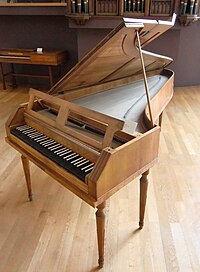Piano Concerto No. 10 (Mozart)
| Concerto for two pianos | |
|---|---|
| No. 10 | |
| by W. A. Mozart | |

Pianoforte by Johann Andreas Stein (Augsburg, 1775) – Berlin, Musikinstrumenten-Museum
|
|
| Key | E-flat major |
| Catalogue | K. 365 |
| Composed | 1779 |
| Movements | Three (Allegro, Andante, Rondo, Allegro) |
| Scoring |
|
The concerto was originally scored for the two pianos together with two oboes, two bassoons; two horns; and strings. Mozart later expanded the score with pairs of clarinets, trumpets and timpani in E flat and B flat. The piece is in three movements:
The concerto departs from the usual solo piano concerto with the dialogue between the two pianos as they exchange musical ideas. Mozart divides up the more striking passages quite evenly between the two pianos. Also, the orchestra is rather more quiet than in Mozart's other piano concertos, leaving much of the music to the soloists.
The first movement is lyrical and "wonderfully spacious, as if Mozart is thoroughly enjoying himself and letting his ideas flow freely," as Ledbetter has noted. The middle movement is slow and refined; the orchestra stays in the background behind the pair of playful pianists. The finale is a rondo filled with rhythmic drive and, after passages of lyrical grace, there is an exuberant return to the main rondo theme.
...
Wikipedia
